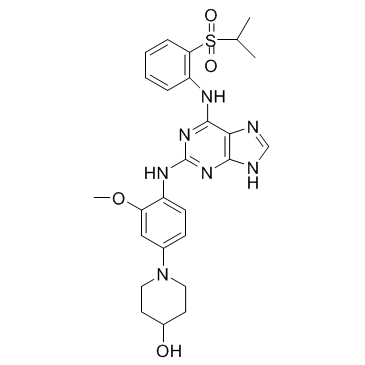| Description |
Mps1-IN-3 is a potent and selective MPS1 kinase inhibitor, with an IC50 of 50 nM.
|
| Related Catalog |
|
| Target |
Mps1:50 nM (IC50)
|
| In Vitro |
Mps1-IN-3 is a potent MPS1 kinase inhibitor, with an IC50 of 50 nM. Mps1-IN-3 inhibits the proliferation of U251 glioblastoma cells with an IC50 of appr 5 µM. Mps1-IN-3 (2 μM) can completely abrogates checkpoint. Furthermore, Mps1-IN-3 (5 μM) sensitizes all glioblastoma cells (U251, U87, VU147 and GBM8) to 3 nM of vincristine[1].
|
| In Vivo |
Mps1-IN-3 (2 mg/kg, i.v.) sensitizes glioblastoma cells to vincristine in murine tumor models, with prolonged survival and no toxicity[1].
|
| Animal Admin |
Mice[1] Six-week old athymic female nude mice weighing about 25 g are stereotactically injected with 1 × 106 U251-FM-shCTRL or shMPS1 cells, or U251-FM, or 3 × 105 GBM8-FM cells (in 10 and 4 μL PBS, respectively) using a stereotactic instrument after drilling a small hole in the cranium of the mice. For the U251-FM-shRNA experiment, a minimum of 3 mice per group is used, and for the U251-FM and GBM8-FM cells, at least 5 mice per group are used. Tumor growth is monitored by Fluc bioluminescence imaging after injection of 150 μL D-luciferin (50 mg/mL) and imaging 10 min later for luciferase-mediated photon activity using the IVIS Lumina imaging system for the U251-FM model and the IVIS Spectrum for the GBM8-FM model. When tumors reach a size around 107 radiance for the U251 model and 5 × 105 radiance for the GBM8 model, mice are intravenously injected with vehicle, 0.5 mg/kg body weight vincristine in DMSO, and/or 2 mg/kg MPS1-IN-3 in 20% hydroxypropyl-beta-cyclodextrin (HPbetaCD), twice/week over three weeks. Tumor volume is monitored weekly by Fluc imaging[1].
|
| References |
[1]. Tannous BA, et al. Effects of the selective MPS1 inhibitor MPS1-IN-3 on glioblastoma sensitivity to antimitotic drugs. J Natl Cancer Inst. 2013 Sep 4;105(17):1322-31.
|
